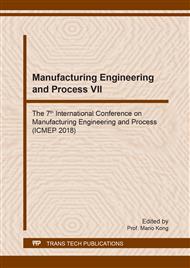[1]
R. L. Plaut, A.F. Padilha, N.B. Lima, C. Herrera, A.F. Filho and L.H. Yoshimura, Medium carbon steel deep drawing: a study on the evolution of mechanical properties, texture and simulations, from cold rolling to the end product,, Materials Science and Engineering A, vol. 499, 2009, pp.337-341.
DOI: 10.1016/j.msea.2007.11.131
Google Scholar
[2]
V.M. Schastlivcev, I.L. Yakovleva, N.V. Koptseva et al, Regularities of structure formation at heat and deformational kinds of processing during the high strength reinforcement manufacturing,, Vestnik of Nosov Magnitogorsk state technical university, vol. 1(45), 2014, pp.32-37.
Google Scholar
[3]
M. Mihalikova, P. Lackova and A. Liskova, Analysis of pearlitic cold drawn steel wire,, Materials Science Forum, vol. 818, 2015, pp.288-291.
DOI: 10.4028/www.scientific.net/msf.818.288
Google Scholar
[4]
O. Potecasu, F. Potecasu, M. Marin, F.B. Marin and F. Chicos, The influence of the deformation degree on the mechanical properties and microstructure of the blanks obtained by tube and wire drawing,, Advanced Materials Research, vol. 1143, 2017, pp.85-90.
DOI: 10.4028/www.scientific.net/amr.1143.85
Google Scholar
[5]
A. Gulin, M. Polyakova and E. Golubchik, Effect of stress-strain state during combined deformation on microstructure evolution of high carbon steel wire,, Solid State Phenomena, vol. 870, 2016, pp.460-465.
DOI: 10.4028/www.scientific.net/msf.870.460
Google Scholar
[6]
F. Fang, X-j. Hu, B-m. Zhang, Z-h.Xie and J-q. Jiang, Deformation of dual-structure medium carbon steel in cold drawing,, Materials Science and Engineering A, vol. 583, 2013, pp.78-83.
DOI: 10.1016/j.msea.2013.06.081
Google Scholar
[7]
N. Guo, B-F. Luan, B-S. Wang and Q. Liu, Microstructure and texture evolution in fully pearlitic steel during wire drawing,, Science China. Technological Sciences, 2013, doi: 10/1007/s11431-013-5184-7.
DOI: 10.1007/s11431-013-5184-7
Google Scholar
[8]
J.W. Pilarczyk, Analysis of reasons for increase of tensile, yield strength and number of twists of wires drawn in pressure dies,, Wire Journal International, vol. 34, iss. 7, 2011, pp.138-147.
Google Scholar
[9]
H. Huang, L. Wang and F. Li, Structure evolution in steel wires during drawing,, Advanced Materials Research, vols. 194-196, 2011, pp.218-223.
DOI: 10.4028/www.scientific.net/amr.194-196.218
Google Scholar
[10]
G. Oplatka, M. Roth and P. Vaclavic, Influence of a plastic bending deformation on the lifetime of wires and ropes,, Proc. the 9th Congress on Material Testing, 1986, pp.44-48.
Google Scholar
[11]
P. Gillstrom and M. Jarl, Mechanical descaling of wire rod using reverse bending and brushing, Journal of Materials Processing Technology, vol. 172, iss. 3, 2006, pp.332-340.
DOI: 10.1016/j.jmatprotec.2005.10.014
Google Scholar
[12]
C. Cordier-Robert, B. Forfert, B. Bolle, J-J. Fundenberger and A. Tidu, Influence of torsion deformation on microstructure of cold-drawn pearlitic steel wire,, Journal of Materials Science, vol. 43, 2008, pp.1241-1248.
DOI: 10.1007/s10853-007-2272-8
Google Scholar
[13]
N. Guo, B. Song, B-S. Wang and Q. Liu, Influence of torsion deformation on textures of cold drawing pearlitic steel wires,, Acta Metall Science, vol. 28, iss. 6, 2015, pp.707-714.
DOI: 10.1007/s40195-015-0251-7
Google Scholar
[14]
I. Verpoest, B.D. Notohardjono and E. Aernoudt, Fatigue of steel wire under combined tensile and shear loading,, ASTM Special Technical Publication, 1985, pp.361-377.
DOI: 10.1520/stp36232s
Google Scholar
[15]
M. Zelin and R.M. Shemenski, Ductility of pearlitic wires under different loadings,. Conference Proceedings of the Wire Association International, Wire Expo, 2006, pp.1-14.
Google Scholar
[16]
I. Saunders and J. Nutting, Deformation of metals to high strains using combination of torsion and compression,, Metal science, vol. 18, iss. 12, 1984, pp.571-575.
DOI: 10.1179/030634584790419629
Google Scholar
[17]
P. Funke, C. Pavlidis and I. Piorko, Continuous cross section reduction as a result of combined bending and drawing: effect on the strength characteristics of a special deep drawing steel,, DFBO Mitt, vol. 24, iss. 9, 1973, pp.154-159.
Google Scholar
[18]
Patent for the invention № 2467816. Method for producing ultrafine semiproducts by drawing with torsion / M.V. Chukin, M.A. Polyakova, E.M. Golubchik, V.P. Rudakov, S.E. Noskov and A.E. Gulin. Appl. 28.02.2011. Publ. 27.11.(2012).
Google Scholar
[19]
Patent for the usable model №130525. Setup for manufacturing the steel wire with ultrafinegrain structure / M.A. Polyakova, M.V. Chukin, E.M. Golubchik and A.E. Gulin. Appl. 04.02.2013. Publ. 27.07.(2013).
Google Scholar
[20]
N.A. Terezshenko, I.L. Yakovleva, T.A. Zubkova et al, Structural levels of pearlite deformation in carbon eutectoid steel,, Metall physics and metallography, vol. 114, iss. 5, 2013, pp.468-480 (in Russian).
DOI: 10.1134/s0031918x13050116
Google Scholar
[21]
V.M. Schastlivcev, D.A. Mirzaev, I.L. Yakovleva et al. Pearlite in carbon steels,, Ekaterinburg: Ural branch of Russian academy of science, 2006, 311 p. (in Russian).
Google Scholar
[22]
V.P. Feoktistov, Structural aspects of plasticity decrease of high strength wire at high total compression,, Casting and metallurgy, vol. 4 (68), 2012, pp.107-109.
Google Scholar
[23]
M. Chukin, M. Polyakova, A. Gulin, O. Nikitenko, The possibility of manufacturing long-length metal products with ultra-fine grain structure by combination of strain effects,, Key Engineering Materials, vol. 685, 2016, pp.487-491.
DOI: 10.4028/www.scientific.net/kem.685.487
Google Scholar
[24]
M. Chukin, M. Polyakova and A. Gulin, Influence of hybrid plastic deformation on the microstructure and mechanical properties of carbon-steel wire,, Steel in Translation, vol. 46, iss. 8, 2016, pp.548-551.
DOI: 10.3103/s0967091216080076
Google Scholar
[25]
М. Polyakova, I. Calliari and A. Gulin, Effect of microstructure and mechanical properties formation of medium carbon steel wire through continuous combined deformation,, Key Engineering Materials, vol. 716, 2016, pp.201-207.
DOI: 10.4028/www.scientific.net/kem.716.201
Google Scholar


